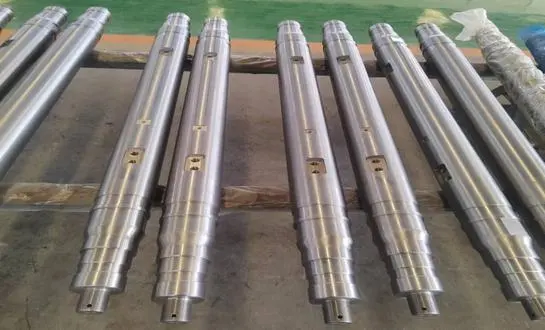Why are forged shafts preferred in heavy machinery applications?
Enhanced Structural Integrity
Forged shafts exhibit superior structural integrity compared to their cast or machined counterparts. The forging process aligns the metal's grain structure, resulting in a more uniform and dense material composition. This alignment significantly enhances the shaft's ability to withstand torsional and bending stresses, which are common in heavy machinery operations. The improved microstructure also contributes to better fatigue resistance, ensuring that the shaft can endure repetitive loading cycles without premature failure.
Customizable Mechanical Properties
The forging process allows for precise control over the mechanical properties of the shaft. By adjusting parameters such as forging temperature, deformation rate, and cooling methods, manufacturers can tailor the shaft's characteristics to meet specific application requirements. This flexibility enables the production of shafts with optimized strength-to-weight ratios, enhanced ductility, or improved wear resistance, depending on the intended use in heavy machinery.
Improved Reliability and Safety
Forged shafts are inherently more reliable due to their homogeneous structure and reduced likelihood of internal defects. The forging process eliminates voids and inclusions that can act as stress concentration points, thereby minimizing the risk of sudden failure. This increased reliability translates directly to improved safety in heavy machinery operations, where component failure can lead to catastrophic consequences. The predictable performance of forged shafts allows for more accurate maintenance scheduling and extends the overall lifespan of the machinery.
Key benefits of forged components in mining and construction equipment
Exceptional Wear Resistance
In the harsh environments of mining and construction sites, equipment components are subjected to severe abrasion and impact. Forged components, including shaft forging products, demonstrate superior wear resistance due to their dense, uniform structure. This characteristic is particularly valuable in applications such as excavator arms, crusher shafts, and drilling equipment, where constant exposure to abrasive materials can quickly degrade lesser-quality parts. The enhanced durability of forged components significantly reduces downtime for repairs and replacements, thereby improving overall operational efficiency.
High Strength-to-Weight Ratio
Forged components offer an optimal balance between strength and weight, a critical factor in the design of mining and construction equipment. The forging process allows for the creation of parts with complex geometries that maximize strength while minimizing material usage. This results in machinery that is both powerful and fuel-efficient. For instance, forged crankshafts in heavy-duty engines can withstand enormous forces while being lighter than cast alternatives, contributing to improved engine performance and reduced fuel consumption.
Corrosion Resistance
Mining and construction environments often expose equipment to corrosive elements such as moisture, chemicals, and saltwater. Forged components, particularly those made from alloy steels or stainless steels, exhibit excellent corrosion resistance. The dense, non-porous surface created by the forging process provides an additional barrier against corrosive agents. This resistance to corrosion ensures that critical components, like hydraulic cylinder rods and support structures, maintain their integrity over extended periods, even in the most challenging environments.
How does shaft forging improve load-bearing capacity in cranes?
Enhanced Material Flow and Grain Structure
The shaft forging process significantly improves the load-bearing capacity of crane components through its unique ability to enhance material flow and grain structure. During forging, the metal is subjected to intense pressure and heat, causing its internal grain structure to align in the direction of material flow. This alignment results in a more uniform and denser microstructure compared to casting or machining. In crane applications, where shafts are subjected to enormous stresses from lifting and moving heavy loads, this improved grain structure translates to superior strength and resilience. The forged shafts can withstand higher loads without deformation or failure, allowing cranes to operate at higher capacities with an increased safety margin.
Optimized Stress Distribution
Forged shafts used in cranes benefit from optimized stress distribution throughout their structure. The forging process allows for the creation of near-net-shape components with varying cross-sections tailored to the specific stress patterns encountered in crane operations. This means that areas of the shaft that experience higher stresses can be reinforced during the forging process, while less critical areas can be designed to reduce overall weight. The result is a shaft that efficiently distributes loads, minimizing stress concentrations that could lead to premature failure. This optimized stress distribution is particularly crucial in jib cranes and tower cranes, where the ability to handle eccentric loads safely is paramount.
Increased Fatigue Resistance
Crane shafts are subjected to cyclic loading patterns that can lead to fatigue failure over time. Shaft forging significantly enhances the fatigue resistance of these critical components. The forging process eliminates internal defects and creates a more homogeneous material structure, reducing the number of potential crack initiation sites. Additionally, the compressive stresses induced during forging can help to close any microscopic flaws that might exist in the material. This increased fatigue resistance allows forged crane shafts to withstand a higher number of load cycles before showing signs of wear or fatigue, thereby extending the operational life of the crane and reducing the frequency of maintenance and replacements.
In conclusion, the applications of forged components in heavy machinery, particularly in the realm of shaft forging, demonstrate the critical role these precision-engineered parts play in ensuring the reliability, efficiency, and safety of industrial equipment. From enhancing structural integrity and customizing mechanical properties to improving wear resistance and load-bearing capacity, forged components offer unparalleled advantages in various sectors, including mining, construction, and crane operations. As industries continue to push the boundaries of what's possible with heavy machinery, the demand for high-quality forged components is likely to grow. For those seeking to optimize their heavy machinery performance or explore custom forging solutions, Welong stands ready to provide expert guidance and top-tier products. To learn more about our forging capabilities and how they can benefit your operations, please contact us at oiltools15@welongpost.com.





